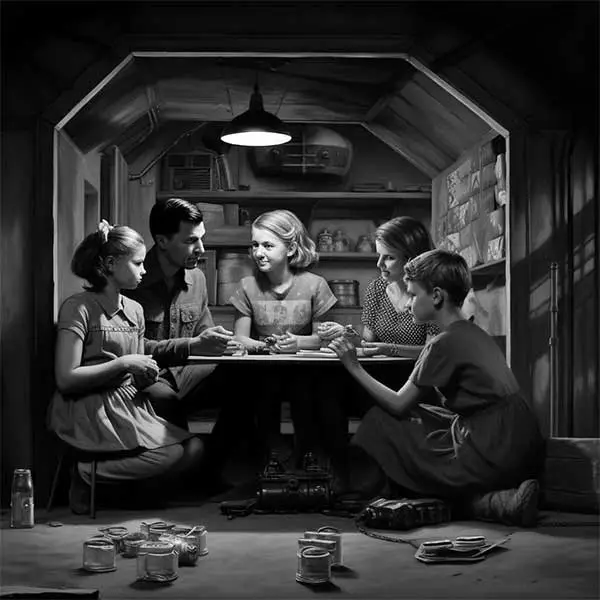At the end of World War II, many American families rejoiced in the defeat of Nazi Germany and the Axis powers.
Others, however, were too busy being swept up in the panic that would develop regarding the potential cold war between the United States and the Soviet Union.
With the threat of a nuclear war on the horizon, Americans sought ways to protect themselves from the horrible destruction. Many chose to fortress themselves in “bomb-proof” fallout shelters.
Introduction
In the shadow of the Cold War, fallout shelters became emblematic of the fears and anxieties of the nuclear age. These underground structures were designed to protect individuals from the radioactive fallout of a nuclear explosion. In this article, we’ll delve into these shelters’ history, design, and relevance in today’s world.
Historical Context
The proliferation of nuclear weapons during the Cold War between the United States and the Soviet Union led to heightened tension and fear of a nuclear apocalypse. Both superpowers had vast arsenals capable of causing unparalleled devastation. This backdrop catalyzed the creation and promotion of fallout shelters, especially in the 1950s and 1960s.
Design and Features
Fallout shelters were designed to be deep enough underground to provide significant shielding from the radioactive fallout and robust enough to withstand the initial blast from a nearby nuclear explosion.
- Depth: The deeper the shelter, the better. Ideally, a fallout shelter would be at least 10 feet underground to provide adequate protection.
- Entrance: The entrance was constructed with a 90-degree turn to prevent direct radiation from entering.
- Ventilation: Proper ventilation was vital. Air intakes and exhausts were fitted with filters to prevent radioactive particles from entering.
- Provisions: Shelters were stocked with essential supplies like water, non-perishable food, medical supplies, and communication tools to support inhabitants for at least two weeks, during which radiation levels would be at their highest.
Public and Private Shelters
While many private citizens built shelters in their backyards, the U.S. government also established larger community fallout shelters. Public buildings like schools and courthouses were often marked with distinctive yellow and black fallout shelter signs, indicating that they had a space designated for protection against nuclear fallout.
Fallout shelters sprung up across the United States, with many citizens building their own by hand and others purchasing commercially designed and built models from catalogs. Most looked like basic units, providing space only for necessities (generally only two-week supplies), while others looked like tiny guest houses equipped with pool tables, paintings, and wine cellars.
Decline and Current Relevance
Interest in the fallout shelter peaked in the early 1960s as the Cuban Missile Crisis loomed and gradually waned in the 1970s as various superpowers’ treaties and agreements calmed American fears. The Fallout Shelter succeeded as a comfort to much of the population and as a money generator for an opportunistic new industry. As détente set in and the imminent threat of nuclear war waned, public interest in fallout shelters diminished. Today, many of these public shelters have been repurposed or forgotten.
 However, with the rise of new geopolitical tensions and nuclear-capable states in recent years, there has been a renewed interest in fallout shelters. Additionally, the prepper community, motivated by various disaster scenarios, has kept the concept alive, modernizing the idea and integrating current technologies.
However, with the rise of new geopolitical tensions and nuclear-capable states in recent years, there has been a renewed interest in fallout shelters. Additionally, the prepper community, motivated by various disaster scenarios, has kept the concept alive, modernizing the idea and integrating current technologies.
Conclusion
The fallout shelter, a powerful symbol of Cold War fears, remains a testament to humanity’s desire for survival in the face of existential threats. While the fervor around them has diminished since the height of the Cold War, the underlying concept remains relevant. As long as nuclear weapons exist and geopolitical tensions ebb and flow, the idea of a protective space against the devastating effects of nuclear warfare will always hold a certain allure.






 Like Us on Facebook
Like Us on Facebook Tweet Us on Twitter
Tweet Us on Twitter Watch Us on YouTube
Watch Us on YouTube Pin Us on Pinterest
Pin Us on Pinterest Link to Us on LinkedIn
Link to Us on LinkedIn Adscape International, LLC
Adscape International, LLC PO Box 173 Brandywine, MD 20613
PO Box 173 Brandywine, MD 20613 240-244-9660
240-244-9660